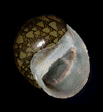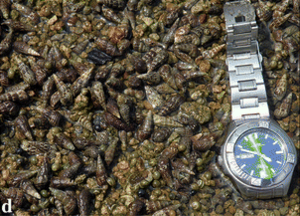Clithon oualaniense facts for kids
Quick facts for kids Clithon oualaniense |
|
|---|---|
 |
|
| Clithon oualaniense shell | |
 |
|
| Clithon oualaniense shells | |
| Conservation status | |
| Scientific classification | |
| Genus: |
Clithon
|
| Species: |
oualaniense
|
| Synonyms | |
|
Neritina oualaniensis Lesson, 1831 |
|
Clithon oualaniense is a type of snail that lives in brackish water. This means it lives where fresh water mixes with salty ocean water. It's a small, aquatic creature belonging to a group called gastropods, which includes all snails and slugs. Like many snails, it has a special "trapdoor" called an operculum that can close its shell opening. It is part of the Neritidae family, often called nerite snails.
Where It Lives
Clithon oualaniense snails are found in a wide area called the Indo-Pacific region. You can find them in places like Japan, Hong Kong, Thailand, and Singapore. They also live in Indonesia, the Philippines, Papua New Guinea, and parts of Australia. These snails are also present on many Pacific islands, including Fiji, Guam, and Samoa.
What It Looks Like
The shell of Clithon oualaniense can have many different patterns and colors. This means that no two snails might look exactly alike! Their shells show a lot of natural variation.
How It Lives
Clithon oualaniense is a very adaptable snail. It can live in different kinds of environments. These snails prefer soft, muddy areas along the coast where the tide goes in and out. This area is called the intertidal zone.
Sometimes, you can find many of these snails living close together. Scientists have counted as many as 347 snails in just one square meter! They can also live in areas where sea grass grows, like beds of Zostera japonica.
Daily Life
Clithon oualaniense snails are most active during the day. They are busy feeding and finding mates when the tide is low. When the tide comes in and the water gets deep, they often bury themselves in the mud. This helps them hide from animals that might want to eat them.
What It Eats
These snails are herbivorous, which means they eat plants. They mostly feed on tiny algae that grow on surfaces. They also eat detritus, which is small bits of dead plants and animals.



